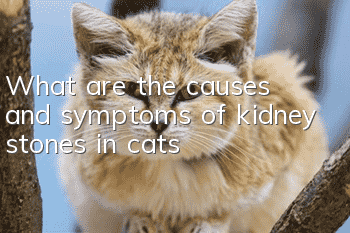What are the causes and symptoms of kidney stones in cats?

As the name suggests, feline kidney stones are a stone growing in the kidneys. Kidney stones are a relatively painful disease for cats and can occur in both male and female cats. In recent years, many cats have suffered from kidney stones. So what are the causes of cats suffering from kidney stones?
Causes of kidney stones in cats
Both dogs and cats can get kidney stones. The reasons why pets suffer from kidney stones are very complex and are mainly related to the pet’s diet, amount of exercise, genetics, etc. Specifically, it may be mainly due to the following reasons:
The pet’s diet is too simple (for example, it always eats meat and no other food), the diet structure is unreasonable; it drinks too little water; it lacks exercise; or the pet itself has metabolic genetic defects and reduced liver function; chronic Inflammation stimulation, etc. In addition, purebred pets are relatively more susceptible to kidney stones than crossbred pets.
Symptoms of kidney stones in cats
If your cat suffers from kidney stones, then its urinary system will definitely experience abnormalities such as: frequent urination, oliguria, polyuria, pain during urination, blood in the urine, etc. Of course, these symptoms do not mean kidney stones, but they can be diagnosed by taking X-rays.
1. The clinical manifestations vary greatly depending on the cause, composition, size, number, location, mobility, obstruction and infection of the stones, and the degree of pathological damage to the renal parenchyma. In mild cases, there may be no symptoms at all, while in severe cases, anuria, renal failure, toxic shock, and death may occur.
2. When stones are embedded in the junction of the renal pelvis and ureter or descend in the ureter, renal colic may occur, which is a sudden attack of paroxysmal knife-like pain. The pain is severe and unbearable. The sick cat is restless and the pain starts from the waist. Or the side of the abdomen radiates downward to the bladder area, vulva and inner thighs. Sometimes there is profuse sweating, nausea and vomiting.
3. Because stones cause serious damage to the mucosa, gross hematuria often occurs. Pain and hematuria are often induced when sick cats move more. When stones are complicated by infection, pus cells appear in the urine, causing symptoms of frequent urination and painful urination.
4. When secondary acute pyelonephritis or pyonephrosis occurs, systemic symptoms such as fever, chills, and chills may occur. Complete obstruction by bilateral upper urinary tract stones or kidney stones can lead to anuria.
- How to clean up cat hair inhaled into the human body
- Does Lan Baiying recognize the owner?
- Can cats eat cooked ginger and garlic?
- What should you do if your cat snores loudly? Cat Feeding Guide!
- What to do if the kitten keeps meowing?
- Causes and treatments for cat diarrhea
- Will cats be poisoned if they smell pesticides?
- Long-haired cats start to lose hair after a few months
- How many years is a cat's age equivalent to a human's age?
- How to deworm a cat successfully



